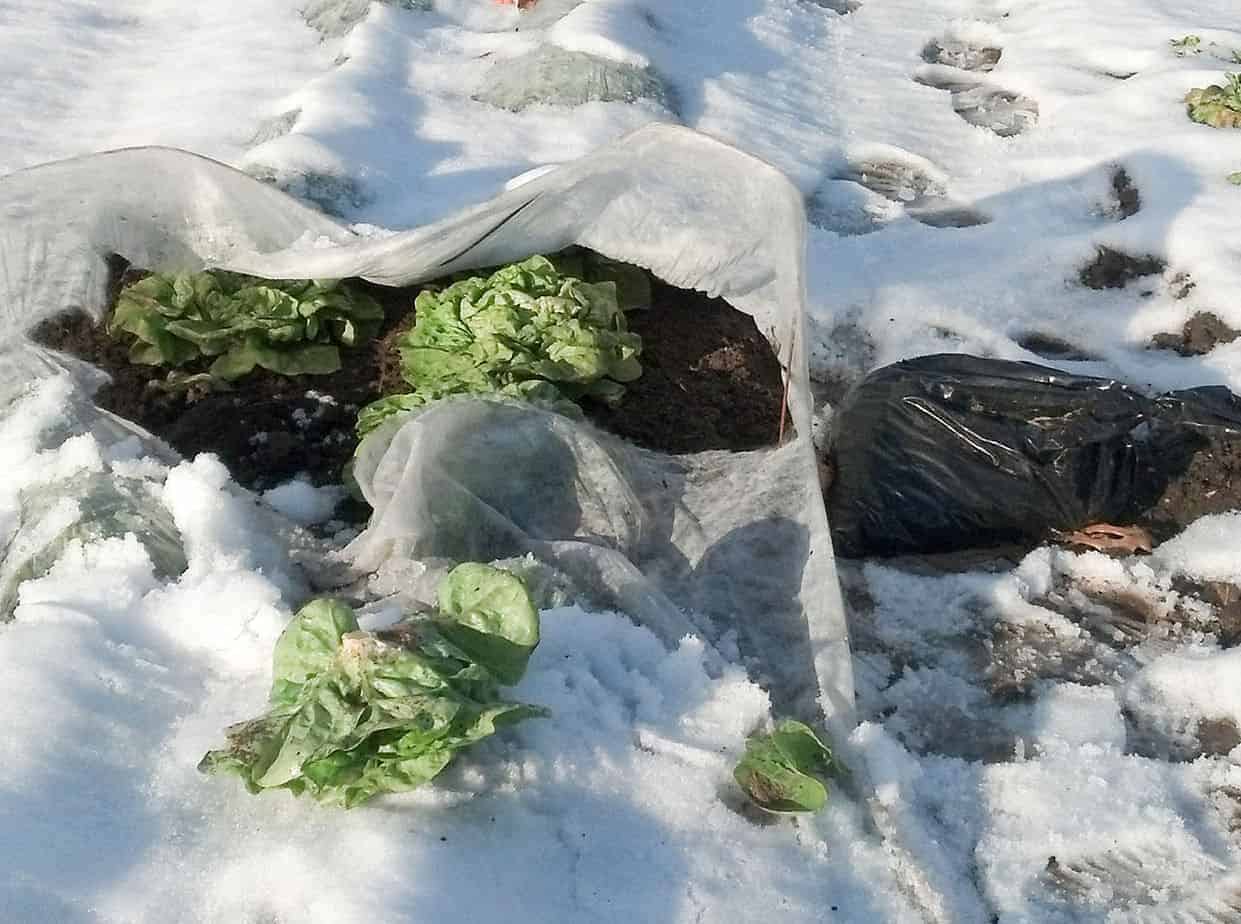Lettuce is one of the easiest vegetables to grow in fall and is quickly becoming my favorite winter vegetable, outdoors and indoors. In fact, lettuce prefers growing in cool weather.
However, just because it’s easier to successfully grow lettuce in cold weather, that doesn’t mean there aren’t some things to consider before you start planting.
On this page:
What to Consider When Growing Lettuce in Cold Weather
Lettuce is considered a cool-weather crop, so it grows best in cool or even cold weather. That’s because long, hot days will trigger lettuce to go to seed. Referred to as bolting, lettuce will start sending up a flower stalk when temperatures get too high. This marks the end of the lettuce plant’s life cycle, and any new leaves will be smaller and more bitter.
So, growing lettuce in cold weather will actually give you more time for multiple lettuce harvests off the same plant, even if it grows more slowly.
In addition, keep in mind that if you are growing in the fall or winter, when the days keep getting shorter and shorter, that means your lettuce is getting less sun overall and therefore less energy for growth, causing them to grow slower than spring-planted lettuce.
Unless you are facing deep frosts, you don’t even need to protect lettuce in cold weather. However, if your temperatures are consistently just above freezing, you can use a row cover or clear garden plastic sheeting to raise the ambient temperature and increase their growth rate.
If you live in a zone with freezing winters, you will need to take extra measures to ensure your lettuce can keep growing during the frigid months.
Can I Grow Lettuce in Winter?
Lettuce can survive light frosts quite easily, but the harder the frost, the more leaf damage you can expect. Frost damage starts around the thin edges of lettuce leaves, but light frosts won’t kill the entire plant.
Planting Lettuce for Fall/Winter Harvests
While you can grow lettuce well into fall and winter, I recommend planting them earlier. For example, if you want to harvest lettuce well into November and December, you should sow your seeds sometime in September or early October. This will give your lettuce the boost from that last bit of warm weather while it’s small, so it will be able to quickly mature by the time the frosty nights start setting in.
If you are succession planting lettuce again and again throughout the winter, you should sow them indoors first before transplanting them outside, unless you have a warm greenhouse to keep the seedlings toasty.

Growing Lettuce Outdoors in Winter
If you want to grow lettuce outdoors in winter, it will depend what your average lowest temperatures are in winter. To find this out, you can find what USDA Hardiness Zone you’re in, which will tell you the average lowest temperature in your area. You can find your hardiness zone using this tool, based on your ZIP code. For example, if you are in Columbus, OH, you are in zone 6a, which means you can expect an average lowest temperature of -10°F to -5°F.
Multiple layers of plastic will provide even better protection. For instance, can use a cold frame to cover a raised bed and inside the cold frame have a plastic row cover over your lettuce. If you have lettuce growing in a greenhouse or high tunnel, you can cover them with garden fleece or garden plastic, again giving double protection.
You can see a great example of what you can achieve with an unheated greenhouse with outside temperatures as low as -23°F (-31°C):
With even modest protection like a plastic cover, lettuce can survive even when outside temperatures get as low as 10°F (-12 °C), similar to kale. There are some gardeners who will grow lettuce all winter long under protection.
Growing Lettuce Indoors in Winter
Another option for growing lettuce in winter is to grow them indoors. Lettuce is one of the easiest plants to grow indoors because of their rapid growth and low to moderate light requirements.
You have two options to grow lettuce indoors: growing lettuce in a pot and growing lettuce hydroponically.
For most gardeners, a pot will suffice, and I’ve already gone into more detail about growing lettuce in a pot, but in brief, a pot size of 1 gallon (3.8 L), at least 6 inches (15 cm) deep is good enough per lettuce plant. Because lettuce has low to moderate light requirements, you can grow them under fluorescent lights like T5 lights or CFL grow lights, or you can get a relatively cheap LED grow light. Always make sure the light is at least a few inches above the plants, because if it’s too close, it can cause heat stress (and therefore bolting) or even burn the leaves.
Harvesting Lettuce Grown in Cold Weather
There are two ways to harvest lettuce: harvesting the entire head or harvesting the outer leaves while letting the rest of the lettuce plant continue growing, called the cut-and-come-again method.
Normally, you can do either, although I always recommend cut-and-come-again harvesting, but when growing lettuce in winter, it’s essential. The reason is because lettuce grown in cold weather is already growing more slowly, so harvesting the entire head, even if you leave the bottom crown, will cause your lettuce to take a very long time to recover.
By harvesting the outer leaves and leaving the smaller central leaves to grow, your lettuce will be able to absorb more energy from the sun and use that energy for leaf growth.
Lettuce Varieties Suited for Cold Weather
While all lettuce prefers cool weather, some varieties are more hardy than others. For example, Winter Density (butterhead/romaine cross), Cimmaron (red romaine), Rouge d’Hiver (red romaine), Winter Marvel (butterhead), and North Pole (butterhead) are all very hardy and can grow well throughout the winter with some protection.
